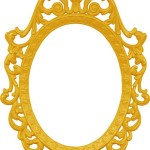How to Glue a Big Mirror on the Wall
Adhering a large mirror to a wall with glue is a viable alternative to traditional hanging methods, particularly when dealing with delicate walls or wanting a seamless appearance. This method offers a strong bond, eliminating the need for visible holes or hanging hardware. However, it requires careful planning and execution to ensure a successful and secure installation.
1. Prepare the Mirror and Wall
Before applying any adhesive, meticulous preparation is crucial for a successful bond.
Mirror Preparation:
- Clean the Mirror Surface: Remove any dust, dirt, grease, or residue from the mirror's back using a mild detergent and a microfiber cloth. Ensure the surface is completely dry before proceeding to the next step.
- Apply Protective Tape: To prevent damage to the mirror during handling and installation, mask the edges with painter's tape, leaving a small margin around the adhesive application area.
Wall Preparation:
- Choose the Correct Wall Surface: Confirm that the chosen wall surface is suitable for gluing. Concrete, drywall, and plaster are generally suitable, while textured walls or those with a loose finish may require additional preparation.
- Clean the Wall Area: Thoroughly clean the designated wall area using a mild detergent and a damp cloth. Allow the area to dry entirely before proceeding.
- Prime the Wall (Optional): If the wall surface is porous or uneven, applying a primer can improve adhesion. Choose a primer compatible with the wall material and the type of adhesive you'll be using.
2. Selecting the Right Adhesive
The choice of adhesive is paramount for a secure and long-lasting bond. Consider the following factors:
Mirror Size and Weight: Ensure the adhesive you choose can handle the weight of the mirror. Heavy mirrors require a stronger adhesive with a higher bonding strength.
Wall Type and Finish: The type of wall surface dictates the most suitable adhesive. Concrete, drywall, and plaster walls may require different types of adhesive.
Moisture Conditions: If the mirror will be installed in a high-humidity environment, choose an adhesive specifically designed for such conditions.
Safety and Odor: Select an odorless and low-VOC (Volatile Organic Compound) adhesive for interior use, especially in enclosed spaces.
3. Applying the Adhesive and Installing the Mirror
After meticulous preparation, the application of the adhesive and installation of the mirror require careful execution.
Applying Adhesive:
- Read and Follow the Manufacturer's Instructions: Carefully read and follow the manufacturer's instructions for the specific adhesive you have chosen, paying close attention to application techniques and drying times.
- Apply Adhesive to the Mirror: Use a bead of adhesive around the perimeter of the mirror's back, or apply dots at strategic points, based on the manufacturer's recommendations.
- Ensure Even Distribution: Use a notched trowel or a putty knife to distribute the adhesive evenly, creating a thin, consistent layer.
Installing the Mirror:
- Position the Mirror: Carefully position the mirror on the wall, ensuring it is level and straight.
- Press Firmly: Firmly press the mirror against the wall, distributing the adhesive evenly. Use a level to ensure the mirror remains straight.
- Apply Additional Pressure: If needed, apply additional weight or pressure to the mirror to create a stronger bond, particularly for larger, heavier mirrors.
- Allow Drying Time: Allow the adhesive to dry completely, adhering to the manufacturer's specified drying time. Avoid touching or moving the mirror until the adhesive has cured.
Important Considerations:
- Seek Professional Assistance: For very large or heavy mirrors, consider seeking professional help from a qualified installer to ensure the secure and proper installation.
- Safety Precautions: Wear appropriate protective gear, such as gloves and safety glasses, when working with adhesives. Work in a well-ventilated area, and avoid contact with the adhesive on skin or eyes.
- Test Before Installation: If unsure about a particular adhesive or method, test it on a small, inconspicuous area of the wall before proceeding with the entire installation.

How To Glue A Heavy Mirror The Wall Mom Blog Society

How To Hang A Large Wall Mirror Step By Tutorial

Gym Mirror Installation How To Hang Mirrors On A Wall With Glue

How To Remove A Mirror Glued The Wall Forbes Home

How To Hang A Mirror With No Slip Adhesive

How To Safely And Easily Remove A Large Bathroom Builder Mirror From The Wall Site Title

How To Remove A Glued Bathroom Mirror From The Wall

How To Safely And Easily Remove A Large Bathroom Builder Mirror From The Wall Site Title

How To Hang A Large Wall Mirror Step By Tutorial

How To Hang A Mirror On Wall Without Nails








